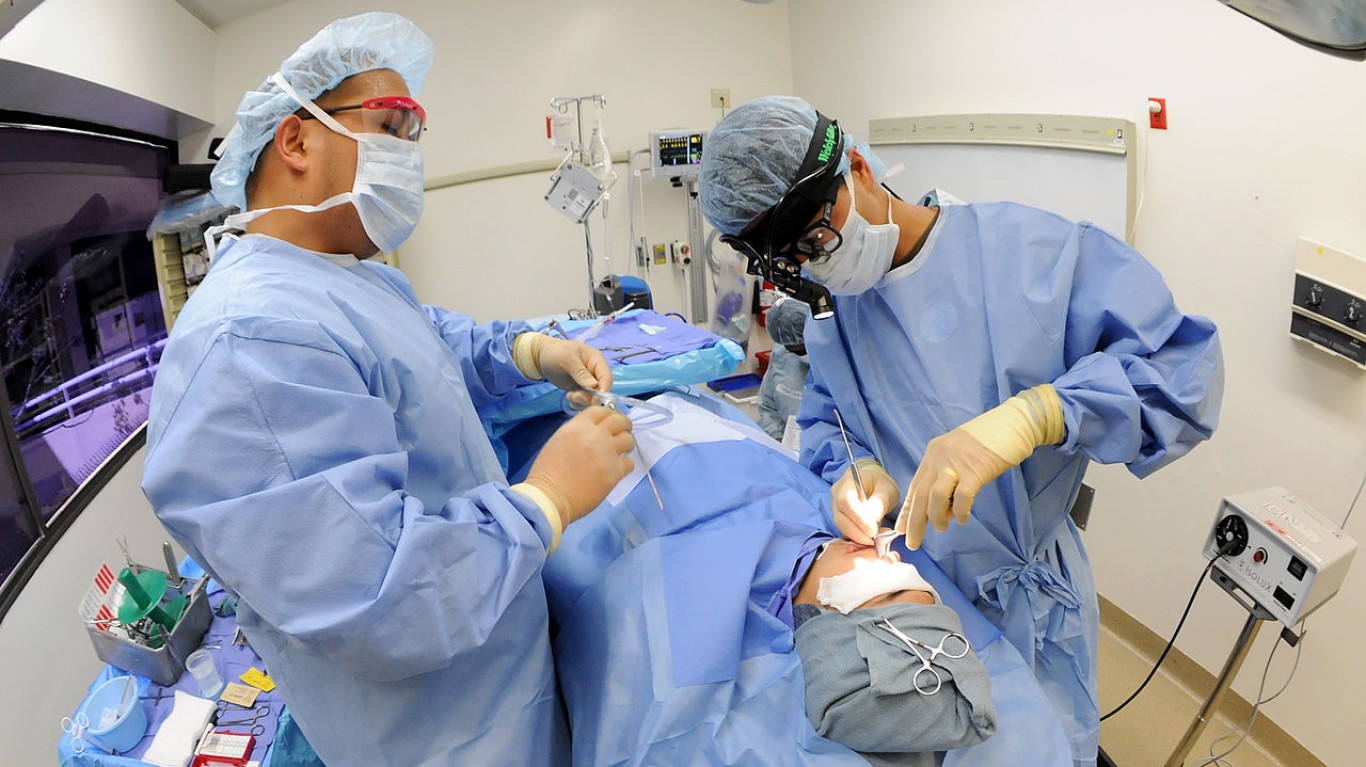
Choosing a career is one of the most consequential decisions many will make in their lifetime. The right job for one person is not necessarily the best choice for another, and a person’s job is often a reflection of personal values and skill sets. Regardless, working is a practical necessity for most people, and as such, compensation is also usually an important consideration.
The average working American earns $50,620 a year, but there are dozens of jobs where the average salary is more than double that.
24/7 Wall St. reviewed average annual salaries for over 800 occupations from the Bureau of Labor Statistics to identify the 77 jobs with six-figure salaries. Such high-paying jobs are relatively rare — and often hard to get. Of the 142.5 million employed Americans, only 7.8% work in professions where the average salary is at least $100,000.
The jobs that pay the highest average salaries are generally high-skilled positions. More than one-third of them require either a doctoral or professional degree and only two do not require a four-year college education. High-paid workers tend to work under difficult conditions and be in high demand.
The jobs on this list pay more than most for several reasons. Often, the high salaries are justified because there is a premium on the required skill set. Not everyone can be a surgeon, an aerospace engineer, or a mathematician — and the scarcity of those skills helps make those professions high paying.
Click here to see the jobs with six figure salaries.
Click here to see our detailed findings and methodology.

77. Business professors
> Avg. annual wage: $100,270
> 10% of workers earn less than: $37,170
> Typical entry-level edu. required: Doctoral or professional degree
> Total employment: 84,340
> Projected employment chg. 2016-2026: 18.1%
[in-text-ad]

76. Transportation, storage, and distribution managers
> Avg. annual wage: $100,740
> 10% of workers earn less than: $54,300
> Typical entry-level edu. required: High school diploma or equivalent
> Total employment: 118,680
> Projected employment chg. 2016-2026: 6.7%

75. Construction managers
> Avg. annual wage: $101,000
> 10% of workers earn less than: $54,810
> Typical entry-level edu. required: Bachelor’s degree
> Total employment: 263,480
> Projected employment chg. 2016-2026: 11.1%

74. Physics professors
> Avg. annual wage: $101,190
> 10% of workers earn less than: $47,630
> Typical entry-level edu. required: Doctoral or professional degree
> Total employment: 13,710
> Projected employment chg. 2016-2026: 10.0%

73. Veterinarians
> Avg. annual wage: $101,530
> 10% of workers earn less than: $53,980
> Typical entry-level edu. required: Doctoral or professional degree
> Total employment: 69,370
> Projected employment chg. 2016-2026: 18.8%

72. Materials scientists
> Avg. annual wage: $101,910
> 10% of workers earn less than: $51,250
> Typical entry-level edu. required: Bachelor’s degree
> Total employment: 7,470
> Projected employment chg. 2016-2026: 7.1%

71. Industrial-organizational psychologists
> Avg. annual wage: $102,530
> 10% of workers earn less than: $50,730
> Typical entry-level edu. required: Master’s degree
> Total employment: 920
> Projected employment chg. 2016-2026: 8.4%
[in-text-ad-2]

70. Administrative services managers
> Avg. annual wage: $103,380
> 10% of workers earn less than: $52,750
> Typical entry-level edu. required: Bachelor’s degree
> Total employment: 270,100
> Projected employment chg. 2016-2026: 10.1%

69. Art directors
> Avg. annual wage: $103,510
> 10% of workers earn less than: $51,130
> Typical entry-level edu. required: Bachelor’s degree
> Total employment: 38,110
> Projected employment chg. 2016-2026: 5.4%

68. Nurse midwives
> Avg. annual wage: $103,640
> 10% of workers earn less than: $66,500
> Typical entry-level edu. required: Master’s degree
> Total employment: 6,530
> Projected employment chg. 2016-2026: 20.7%

67. Mining and geological engineers
> Avg. annual wage: $103,710
> 10% of workers earn less than: $54,700
> Typical entry-level edu. required: Bachelor’s degree
> Total employment: 6,150
> Projected employment chg. 2016-2026: 8.2%
[in-text-ad]

66. Mathematicians
> Avg. annual wage: $104,700
> 10% of workers earn less than: $52,860
> Typical entry-level edu. required: Master’s degree
> Total employment: 2,730
> Projected employment chg. 2016-2026: 29.7%

65. Physician assistants
> Avg. annual wage: $104,760
> 10% of workers earn less than: $66,590
> Typical entry-level edu. required: Master’s degree
> Total employment: 109,220
> Projected employment chg. 2016-2026: 37.3%

64. Biochemists and biophysicists
> Avg. annual wage: $105,410
> 10% of workers earn less than: $48,410
> Typical entry-level edu. required: Doctoral or professional degree
> Total employment: 27,380
> Projected employment chg. 2016-2026: 11.5%

63. Geoscientists (except hydrologists and geographers)
> Avg. annual wage: $105,830
> 10% of workers earn less than: $48,850
> Typical entry-level edu. required: Bachelor’s degree
> Total employment: 28,520
> Projected employment chg. 2016-2026: 14.0%

62. Application software developers
> Avg. annual wage: $106,710
> 10% of workers earn less than: $59,870
> Typical entry-level edu. required: Bachelor’s degree
> Total employment: 849,230
> Projected employment chg. 2016-2026: 30.7%

61. Electronics engineers (except computer)
> Avg. annual wage: $106,760
> 10% of workers earn less than: $64,030
> Typical entry-level edu. required: Bachelor’s degree
> Total employment: 134,930
> Projected employment chg. 2016-2026: 3.7%
[in-text-ad-2]

60. Sales engineers
> Avg. annual wage: $106,950
> 10% of workers earn less than: $56,940
> Typical entry-level edu. required: Bachelor’s degree
> Total employment: 70,820
> Projected employment chg. 2016-2026: 6.9%

59. Physical scientists, misc.
> Avg. annual wage: $107,180
> 10% of workers earn less than: $50,300
> Typical entry-level edu. required: Bachelor’s degree
> Total employment: 17,320
> Projected employment chg. 2016-2026: 7.2%

58. Nurse practitioners
> Avg. annual wage: $107,480
> 10% of workers earn less than: $74,840
> Typical entry-level edu. required: Master’s degree
> Total employment: 166,280
> Projected employment chg. 2016-2026: 36.1%

57. University education administrators
> Avg. annual wage: $107,670
> 10% of workers earn less than: $52,960
> Typical entry-level edu. required: Master’s degree
> Total employment: 142,160
> Projected employment chg. 2016-2026: 10.1%
[in-text-ad]

56. Computer network architects
> Avg. annual wage: $107,870
> 10% of workers earn less than: $58,160
> Typical entry-level edu. required: Bachelor’s degree
> Total employment: 157,830
> Projected employment chg. 2016-2026: 6.5%

55. Nuclear engineers
> Avg. annual wage: $108,910
> 10% of workers earn less than: $66,400
> Typical entry-level edu. required: Bachelor’s degree
> Total employment: 16,700
> Projected employment chg. 2016-2026: 3.8%

54. Astronomers
> Avg. annual wage: $109,560
> 10% of workers earn less than: $54,110
> Typical entry-level edu. required: Doctoral or professional degree
> Total employment: 2,020
> Projected employment chg. 2016-2026: 10.0%

53. Engineering professors
> Avg. annual wage: $109,830
> 10% of workers earn less than: $50,280
> Typical entry-level edu. required: Doctoral or professional degree
> Total employment: 37,500
> Projected employment chg. 2016-2026: 14.6%

52. Industrial production managers
> Avg. annual wage: $110,580
> 10% of workers earn less than: $61,360
> Typical entry-level edu. required: Bachelor’s degree
> Total employment: 171,520
> Projected employment chg. 2016-2026: -0.5%

51. Medical and health services managers
> Avg. annual wage: $111,680
> 10% of workers earn less than: $58,350
> Typical entry-level edu. required: Bachelor’s degree
> Total employment: 346,980
> Projected employment chg. 2016-2026: 20.5%
[in-text-ad-2]

50. Systems software developers
> Avg. annual wage: $111,780
> 10% of workers earn less than: $65,670
> Typical entry-level edu. required: Bachelor’s degree
> Total employment: 394,590
> Projected employment chg. 2016-2026: 11.1%

49. Political scientists
> Avg. annual wage: $112,030
> 10% of workers earn less than: $56,150
> Typical entry-level edu. required: Master’s degree
> Total employment: 6,320
> Projected employment chg. 2016-2026: 2.8%

48. Chemical engineers
> Avg. annual wage: $112,430
> 10% of workers earn less than: $62,230
> Typical entry-level edu. required: Bachelor’s degree
> Total employment: 33,500
> Projected employment chg. 2016-2026: 7.5%

47. Economists
> Avg. annual wage: $112,650
> 10% of workers earn less than: $56,400
> Typical entry-level edu. required: Master’s degree
> Total employment: 19,550
> Projected employment chg. 2016-2026: 6.3%
[in-text-ad]

46. Managers, misc.
> Avg. annual wage: $113,180
> 10% of workers earn less than: $51,770
> Typical entry-level edu. required: Bachelor’s degree
> Total employment: 430,120
> Projected employment chg. 2016-2026: 8.0%

45. Economics professors
> Avg. annual wage: $114,820
> 10% of workers earn less than: $48,610
> Typical entry-level edu. required: Doctoral or professional degree
> Total employment: 12,770
> Projected employment chg. 2016-2026: 10.6%

44. Actuaries
> Avg. annual wage: $114,850
> 10% of workers earn less than: $59,950
> Typical entry-level edu. required: Bachelor’s degree
> Total employment: 19,210
> Projected employment chg. 2016-2026: 22.5%

43. Aerospace engineers
> Avg. annual wage: $115,300
> 10% of workers earn less than: $70,840
> Typical entry-level edu. required: Bachelor’s degree
> Total employment: 65,760
> Projected employment chg. 2016-2026: 6.1%

42. Training and development managers
> Avg. annual wage: $117,690
> 10% of workers earn less than: $59,170
> Typical entry-level edu. required: Bachelor’s degree
> Total employment: 34,500
> Projected employment chg. 2016-2026: 10.3%

41. Optometrists
> Avg. annual wage: $119,100
> 10% of workers earn less than: $53,740
> Typical entry-level edu. required: Doctoral or professional degree
> Total employment: 37,240
> Projected employment chg. 2016-2026: 17.9%
[in-text-ad-2]

40. Computer and information research scientists
> Avg. annual wage: $119,570
> 10% of workers earn less than: $65,540
> Typical entry-level edu. required: Master’s degree
> Total employment: 27,920
> Projected employment chg. 2016-2026: 19.2%

39. Computer hardware engineers
> Avg. annual wage: $119,650
> 10% of workers earn less than: $66,290
> Typical entry-level edu. required: Bachelor’s degree
> Total employment: 66,770
> Projected employment chg. 2016-2026: 5.5%

38. Air traffic controllers
> Avg. annual wage: $120,260
> 10% of workers earn less than: $67,440
> Typical entry-level edu. required: Associate’s degree
> Total employment: 22,790
> Projected employment chg. 2016-2026: 3.5%

37. Judges, magistrate judges, and magistrates
> Avg. annual wage: $121,050
> 10% of workers earn less than: $35,650
> Typical entry-level edu. required: Doctoral or professional degree
> Total employment: 28,440
> Projected employment chg. 2016-2026: 5.6%
[in-text-ad]

36. Pharmacists
> Avg. annual wage: $121,710
> 10% of workers earn less than: $87,420
> Typical entry-level edu. required: Doctoral or professional degree
> Total employment: 309,330
> Projected employment chg. 2016-2026: 5.6%

35. Purchasing managers
> Avg. annual wage: $121,810
> 10% of workers earn less than: $66,630
> Typical entry-level edu. required: Bachelor’s degree
> Total employment: 70,430
> Projected employment chg. 2016-2026: 5.5%

34. Health specialties professors
> Avg. annual wage: $122,890
> 10% of workers earn less than: $43,200
> Typical entry-level edu. required: Doctoral or professional degree
> Total employment: 194,610
> Projected employment chg. 2016-2026: 25.9%

33. Physicists
> Avg. annual wage: $123,080
> 10% of workers earn less than: $57,430
> Typical entry-level edu. required: Doctoral or professional degree
> Total employment: 16,710
> Projected employment chg. 2016-2026: 14.5%

32. General and operations managers
> Avg. annual wage: $123,460
> 10% of workers earn less than: $44,510
> Typical entry-level edu. required: Bachelor’s degree
> Total employment: 2,212,200
> Projected employment chg. 2016-2026: 9.1%

31. Human resources managers
> Avg. annual wage: $123,510
> 10% of workers earn less than: $65,040
> Typical entry-level edu. required: Bachelor’s degree
> Total employment: 136,310
> Projected employment chg. 2016-2026: 9.1%
[in-text-ad-2]

30. Advertising and promotions managers
> Avg. annual wage: $123,880
> 10% of workers earn less than: $48,150
> Typical entry-level edu. required: Bachelor’s degree
> Total employment: 28,100
> Projected employment chg. 2016-2026: 5.5%

29. Personal financial advisors
> Avg. annual wage: $124,140
> 10% of workers earn less than: $40,800
> Typical entry-level edu. required: Bachelor’s degree
> Total employment: 200,920
> Projected employment chg. 2016-2026: 14.9%

28. Public relations and fundraising managers
> Avg. annual wage: $127,690
> 10% of workers earn less than: $61,130
> Typical entry-level edu. required: Bachelor’s degree
> Total employment: 67,300
> Projected employment chg. 2016-2026: 10.4%

27. Law professor
> Avg. annual wage: $129,840
> 10% of workers earn less than: $40,850
> Typical entry-level edu. required: Doctoral or professional degree
> Total employment: 16,900
> Projected employment chg. 2016-2026: 12.3%
[in-text-ad]

26. Compensation and benefits managers
> Avg. annual wage: $130,010
> 10% of workers earn less than: $68,510
> Typical entry-level edu. required: Bachelor’s degree
> Total employment: 15,520
> Projected employment chg. 2016-2026: 5.0%

25. Natural sciences managers
> Avg. annual wage: $133,670
> 10% of workers earn less than: $62,080
> Typical entry-level edu. required: Bachelor’s degree
> Total employment: 56,210
> Projected employment chg. 2016-2026: 9.9%

24. Sales managers
> Avg. annual wage: $137,650
> 10% of workers earn less than: $57,590
> Typical entry-level edu. required: Bachelor’s degree
> Total employment: 371,410
> Projected employment chg. 2016-2026: 7.5%

23. Lawyers
> Avg. annual wage: $141,890
> 10% of workers earn less than: $57,430
> Typical entry-level edu. required: Doctoral or professional degree
> Total employment: 628,370
> Projected employment chg. 2016-2026: 8.2%

22. Financial managers
> Avg. annual wage: $143,530
> 10% of workers earn less than: $66,480
> Typical entry-level edu. required: Bachelor’s degree
> Total employment: 569,380
> Projected employment chg. 2016-2026: 18.7%

21. Marketing managers
> Avg. annual wage: $145,620
> 10% of workers earn less than: $68,490
> Typical entry-level edu. required: Bachelor’s degree
> Total employment: 218,970
> Projected employment chg. 2016-2026: 10.1%
[in-text-ad-2]

20. Architectural and engineering managers
> Avg. annual wage: $146,290
> 10% of workers earn less than: $88,050
> Typical entry-level edu. required: Bachelor’s degree
> Total employment: 179,990
> Projected employment chg. 2016-2026: 5.5%

19. Podiatrists
> Avg. annual wage: $148,470
> 10% of workers earn less than: $50,930
> Typical entry-level edu. required: Doctoral or professional degree
> Total employment: 9,670
> Projected employment chg. 2016-2026: 10.3%

18. Computer and information systems managers
> Avg. annual wage: $149,730
> 10% of workers earn less than: $83,860
> Typical entry-level edu. required: Bachelor’s degree
> Total employment: 365,690
> Projected employment chg. 2016-2026: 12.0%

17. Petroleum engineers
> Avg. annual wage: $154,780
> 10% of workers earn less than: $74,400
> Typical entry-level edu. required: Bachelor’s degree
> Total employment: 32,010
> Projected employment chg. 2016-2026: 15.2%
[in-text-ad]

16. Airline pilots, copilots, and flight engineers
> Avg. annual wage: $161,280
> 10% of workers earn less than: $68,230
> Typical entry-level edu. required: Bachelor’s degree
> Total employment: 84,070
> Projected employment chg. 2016-2026: 3.4%

15. Nurse anesthetists
> Avg. annual wage: $169,450
> 10% of workers earn less than: $110,520
> Typical entry-level edu. required: Master’s degree
> Total employment: 42,620
> Projected employment chg. 2016-2026: 16.2%

14. Dentists
> Avg. annual wage: $174,110
> 10% of workers earn less than: $69,210
> Typical entry-level edu. required: Doctoral or professional degree
> Total employment: 110,400
> Projected employment chg. 2016-2026: 19.4%

13. Pediatricians
> Avg. annual wage: $187,540
> 10% of workers earn less than: $82,670
> Typical entry-level edu. required: Doctoral or professional degree
> Total employment: 28,990
> Projected employment chg. 2016-2026: 15.4%

12. Chief executives
> Avg. annual wage: $196,050
> 10% of workers earn less than: $68,110
> Typical entry-level edu. required: Bachelor’s degree
> Total employment: 210,160
> Projected employment chg. 2016-2026: -3.9%

11. Prosthodontists
> Avg. annual wage: $196,960
> 10% of workers earn less than: $96,220
> Typical entry-level edu. required: Doctoral or professional degree
> Total employment: 430
> Projected employment chg. 2016-2026: 19.1%
[in-text-ad-2]

10. Internists
> Avg. annual wage: $198,370
> 10% of workers earn less than: $58,770
> Typical entry-level edu. required: Doctoral or professional degree
> Total employment: 42,280
> Projected employment chg. 2016-2026: 14.6%

9. Dentists, misc. specialists
> Avg. annual wage: $199,980
> 10% of workers earn less than: $85,810
> Typical entry-level edu. required: Doctoral or professional degree
> Total employment: 4,590
> Projected employment chg. 2016-2026: 13.3%

8. Family and general practitioners
> Avg. annual wage: $208,560
> 10% of workers earn less than: $73,240
> Typical entry-level edu. required: Doctoral or professional degree
> Total employment: 126,440
> Projected employment chg. 2016-2026: 14.3%

7. Physicians and surgeons, misc.
> Avg. annual wage: $211,390
> 10% of workers earn less than: $60,390
> Typical entry-level edu. required: Doctoral or professional degree
> Total employment: 355,460
> Projected employment chg. 2016-2026: 11.4%
[in-text-ad]

6. Psychiatrists
> Avg. annual wage: $216,090
> 10% of workers earn less than: $71,560
> Typical entry-level edu. required: Doctoral or professional degree
> Total employment: 25,250
> Projected employment chg. 2016-2026: 11.2%

5. Orthodontists
> Avg. annual wage: $229,380
> 10% of workers earn less than: $78,370
> Typical entry-level edu. required: Doctoral or professional degree
> Total employment: 5,080
> Projected employment chg. 2016-2026: 19.3%

4. Obstetricians and gynecologists
> Avg. annual wage: $235,240
> 10% of workers earn less than: $93,200
> Typical entry-level edu. required: Doctoral or professional degree
> Total employment: 18,880
> Projected employment chg. 2016-2026: 15.5%

3. Oral and maxillofacial surgeons
> Avg. annual wage: $242,740
> 10% of workers earn less than: $68,070
> Typical entry-level edu. required: Doctoral or professional degree
> Total employment: 4,800
> Projected employment chg. 2016-2026: 19.1%
[in-text-ad-2]

2. Surgeons
> Avg. annual wage: $251,890
> 10% of workers earn less than: $88,360
> Typical entry-level edu. required: Doctoral or professional degree
> Total employment: 38,600
> Projected employment chg. 2016-2026: 14.4%

1. Anesthesiologists
> Avg. annual wage: $265,990
> 10% of workers earn less than: $123,580
> Typical entry-level edu. required: Doctoral or professional degree
> Total employment: 30,590
> Projected employment chg. 2016-2026: 15.4%
Detailed Findings
Jobs on this list also tend to be high pressure and come with a high degree of responsibility. Particularly for those in medicine, their work can mean the difference between life and death. Additionally, because educational requirements are generally high for these jobs and school can be expensive, the high salaries help incentivize the necessary greater investment in education.
Not only are the jobs on this list generally high skilled, but also they are in demand. Overall employment is projected to grow by 7.4% from 2016 to 2026. For more than two-thirds of the jobs on this list, employment is projected to grow faster than average.
While many occupations on this list are in engineering or management, medical professions dominate. Nearly one-third of all six-figure jobs are in medicine, including 14 of the 15 highest paying jobs.
It is important to note that the salaries listed for these occupations are averages and do not accurately reflect the income of every individual in the field. For example, in over a dozen jobs on this list, 10% of workers earn less than the average salary across all jobs. Salaries can vary within a given occupation due to a number of factors, including job tenure and region of the country.
Methodology
To identify America’s six-figure jobs, 24/7 Wall St. reviewed 2017 annual average pay data for the 809 jobs tracked by the Bureau of Labor Statistics at the detailed occupation level of aggregation. The pay figures, as well as employment totals for each occupation, are for May 2017 — the latest period for which data is available. The projected changes in employment between 2016-2026 are also from the BLS. Projected changes are calculated by adding the job growth over the 10 year period to the estimated amount of replacements needed to fill the jobs when a worker retires or permanently leaves an occupation.
Want to Retire Early? Start Here (Sponsor)
Want retirement to come a few years earlier than you’d planned? Or are you ready to retire now, but want an extra set of eyes on your finances?
Now you can speak with up to 3 financial experts in your area for FREE. By simply clicking here you can begin to match with financial professionals who can help you build your plan to retire early. And the best part? The first conversation with them is free.
Click here to match with up to 3 financial pros who would be excited to help you make financial decisions.
Have questions about retirement or personal finance? Email us at [email protected]!
By emailing your questions to 24/7 Wall St., you agree to have them published anonymously on a673b.bigscoots-temp.com.
By submitting your story, you understand and agree that we may use your story, or versions of it, in all media and platforms, including via third parties.
Thank you for reading! Have some feedback for us?
Contact the 24/7 Wall St. editorial team.
 24/7 Wall St.
24/7 Wall St. 24/7 Wall St.
24/7 Wall St.


